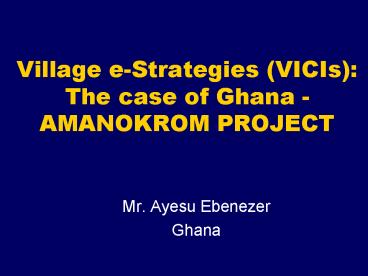Village eStrategies VICIs: The case of Ghana AMANOKROM PROJECT - PowerPoint PPT Presentation
1 / 18
Title:
Village eStrategies VICIs: The case of Ghana AMANOKROM PROJECT
Description:
Village e-Strategies (VICIs): The case of Ghana - AMANOKROM PROJECT. Mr. Ayesu Ebenezer ... bad figure especially at the village level where the woman occupies ... – PowerPoint PPT presentation
Number of Views:40
Avg rating:3.0/5.0
Title: Village eStrategies VICIs: The case of Ghana AMANOKROM PROJECT
1
Village e-Strategies (VICIs) The case of Ghana
- AMANOKROM PROJECT
- Mr. Ayesu Ebenezer
- Ghana
2
Background
- Ghana recognizes that to modernize and develop
its economy and society in the emerging
information and technological age, the nation
will need to embrace ICTs - Ghanas vision is to improve the quality of
life of the people of Ghana by significantly
enriching their social, economic and cultural
well-being through the rapid development and
modernization of economic and society using ICTs
as the main engine for accelerated and
sustainable economic and social development - VICI Amanokrom is a response to take the
national vision to the rural community the
basis of Ghanaian society
3
Amanokrom
4
Objectives
- Develop human resources
- Generate job opportunities
- Advance economic development
- Help build and sustain good governance as a tool
for peaceful co-existence
5
Choice of the Area
- Historical
- Spread of education cocoa
- Technical
- Presence of basic infrastructure as far as
information communication is concerned - The area forms part of both the national
electricity and conventional telephone networks - The area as a catchment to cover wider
educational, health, agricultural, recreational
and other imp. sectors of society - The area has its share of ethnic conflicts but
manages to get back to normal life - The communitys own readiness to own and operate
an ICT facility - Supervision and monitoring
- The closeness of the area to Legon, the base of
the project team
6
The Process
- Notification and consultations
Methodology
- Interviews
- Administration of questionnaire
- Participant observation
- Archival search
7
Developmental challenges 1/2
- Relatively high population growth rate 2.5 ( a
reflection of the national picture) - Relatively youthful population
- High illiteracy rate with about 40 of the
population above age six years without any form
of formal education - The community is part of a country situation
where about 40 live below the poverty line (less
than US1)
8
Developmental challenges 2/2
- Amanokrom has a mainly subsistence agricultural
based economy. In addition, about 70 of the
total agricultural workforce is illiterate. It
is significant to note that women constitute the
highest percentage of the workforce - Amanokrom has a narrow industrial base
- An informal private sector hardly possessing any
potential to generate additional jobs - A dynamic service sector and an enhanced research
and development capacity
9
Priority Focus Areas
- A Globally Competitive Local ICT Industry
- A critical aspect of the growth and
development of key areas of the Amanokrom
political economy involves the development of
globally competitive local ICT industry expressly
focused on the development, production and
distribution of information, knowledge, and
technology products and services. The key areas
are - Human Resource Development
- Education
- Agriculture
- The private sector
- Local governance and administration
- Health
10
Findings 1/3
- The needs assessment was done to find out the
existing ICT resources and potential in
Amanokrom. The main findings of the needs
assessment are - There are some ICT infrastructures in place.
Viz, telephones facilities, radio (fm and am),
cyber cafés, and communication centers. Out of
the 373 respondents, 197 representing 52.8 have
access to mobile telephones, 264 i.e. 70.8 have
access to fixed line phones, 344 i.e. 92.2 have
access to television, 363 i.e. 97.3 radio, 149
i.e. 39.9 to computers, 48 i.e. 12.9 to fax
machines and 267 i.e. 71.6 to video
11
(No Transcript)
12
(No Transcript)
13
Findings 2/3
- There is low computer literacy rate amongst
respondents. This is evident in the study only
20.4 of the total respondents are computer
literate - Most respondents were of the view that ICT can
help them in their socio-economic activities. Of
the 373 people interviewed, 80 i.e. 21.4 used
computers for research 81 i.e. 21.7 use
computers for business and secretarial services
39 i.e. 10.6 use computers for communication, 21
i.e. 5.6 use computers for entertainment, whilst
180 i.e. 48.3 had no idea whatsoever
14
(No Transcript)
15
Findings 3/3
- The study found that more men than women use
ICTs. 60 of the respondents support this
assertion. Also it was found that of the 221
respondents who had heard of ICT 94 were women
which is not a bad figure especially at the
village level where the woman occupies a
subordinate position in society because of her
higher domestic workload, unemployment,
illiteracy, poverty and lack of access to power
and decision making - Amanokrom like the rest of Ghana has a large
percentage of its people below age 31. Out of
the 373 respondents 66.8 falls within this group
16
(No Transcript)
17
Ownership
- Communities
- Project management
Recommendation
- Project to be implemented
18
Thank You !































